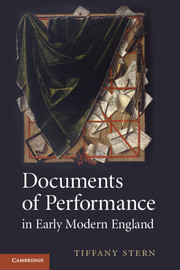Book contents
- Frontmatter
- Contents
- Acknowledgements
- Textual note
- Introduction: Playwrights as play-patchers
- 1 Plot-scenarios
- 2 Playbills and title-pages
- 3 ‘Arguments’ in playhouse and book
- 4 Prologues, epilogues, interim entertainments
- 5 Songs and masques
- 6 Scrolls
- 7 Backstage-plots
- 8 The approved ‘book’ and actors' parts
- Conclusion: Repatching the play
- Notes
- Bibliography
- Index
3 - ‘Arguments’ in playhouse and book
Published online by Cambridge University Press: 18 December 2009
- Frontmatter
- Contents
- Acknowledgements
- Textual note
- Introduction: Playwrights as play-patchers
- 1 Plot-scenarios
- 2 Playbills and title-pages
- 3 ‘Arguments’ in playhouse and book
- 4 Prologues, epilogues, interim entertainments
- 5 Songs and masques
- 6 Scrolls
- 7 Backstage-plots
- 8 The approved ‘book’ and actors' parts
- Conclusion: Repatching the play
- Notes
- Bibliography
- Index
Summary
INTRODUCTION
There is one variety of front matter or ‘paratext’ for a printed play that seems entirely ‘literary’. It is the Argument (‘plot’, ‘device’, ‘subject’, ‘model’) or play summary that is sometimes supplied in playbooks just before the dialogue begins. Critics seldom address it, because the very fact of an Argument is puzzling. Arguments give away a story's ending, and so remove dramatic suspense from the reading of a text, as these closing lines from plot summaries illustrate: ‘Antonio marries Margaretta, … and … fals in love with Dionysia, … but the women come to tragicall ends, and Antonio for upbraiding Julianus with selling his King and Country to the Moore, is by Julianus slaine’; ‘Whereupon, hir brother Cæsar … maketh warre upon Antony, and overcometh him, first at Actium, and then at Pelusium, to the utter ruine and destruction, both of Antony and Cleopatra.’
The few scholars who consider Arguments at all see them in relation to the plays of Terence, Seneca and Plautus, which are regularly preceded by an argumentum (themselves copying the Greek plays of Euripides and Aristophanes that were fronted with a ‘hypothesis’). Arguments before English plays are said to be self-conscious references to classical plays – and to classical plays in a particularly non-performative form, for classical argumenta and hypotheses had, themselves, been added to the texts some decades after performance as aids to readers.
- Type
- Chapter
- Information
- Documents of Performance in Early Modern England , pp. 63 - 80Publisher: Cambridge University PressPrint publication year: 2009

